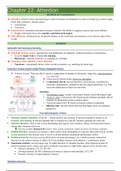Chapter 22: Attention
Attention & Consciousness
Attention: selective focus and narrowing to a part of sensory environment or a class of stimuli (e.g. sensory input,
motor info, memories, internal states)
Unconscious
Conscious
Consciousness: awareness and meta-awareness related to the ability to organize sensory and motor abilities
People with neglect have also cognitive and behavioral neglect
Main difference: attention focus on specific features of the world and consciousness is not selective (gist of the
world)
Attention
Automatic and Conscious processing
Automatic process, covert: unconscious, non-intentional, involuntarily, without awareness or interference
It can be innate trait or obtained by training
Bottom-up : stimulus centered, e.g. stopping at a red light
Conscious, overt: effortful, control, attentive
Top-down : conceptually driven, relies on info in memory e.g. searching for street sign
Treisman’s Feature Search model-Feature integration theory
Feature search: “Pop-out effect” search is independent of number of distractors, target has a pop out feature
e.g. extra tail
Serial search: person scans, distractor dependent
Conjunction search: focused attention, serial process, searching for
particular combinations, similarities between targets-distractors e.g. form
and color differences or thick line and form.
Attention:
1. Pre-attentive stage: stimuli is presented, feature search (biological sign)
2. Attentive stage: is directed to the fixation point-attention spotlight, and all
features are integrated to form a unitary object
3. Perceived (object file) stored in memory (object recognition)
o Odd-face task: sad faces faster detected than happy faces (evolutionary
perspective
Neurophysiological evidence
Neuronal selective attention (V4 & TE – ventral system): pre-training neurons respond to stimuli in all
locations, post-training neuron responds only to stimulus in a specific location, ignoring the extra info
Selective attention: when a task is more demanding and requires extra attention, firing is increased and neuros
change their stimulus selectivity
Pulvinar complex (thalamus) reward = more activity, projections, maybe involved in Treisman’s attention
Divided attention: bottleneck of attention, when a task is more demanding we stop any other task to focus on that,
we pay attention to one task per time, if we try to divide attention (multitask) performance suffers
Parallel processing: serial processing (brief cycles of scene processing), cross-modal (sensory interaction,
decrease in one system increase in other) if one modality requires extra attention = performance drops
Functional evidence: moving target expt i)shift attention, ii) stimulus fixation, when fixation increase in
posterior parietal cortex, left pc was active if stimuli was present in right fields, right pc active in both cases
Selective attention: V4, V3, TE, PP
Divided attention: DLFPC (different activation in selective and bimodal), ACC, PP
Parietal: location, Occipitotemporal: features
Attention networks
, Networks Function/Location Modulation
RAS (reticular activating system): maintain alertness
Noradrenergic system
Alerting Noradrenergic projections from locus coeruleus brain stem
(norepinephrine)
forebrain (preparation for rapid stimulus detection)
Main function is prioritizing of sensory input (modality, location)
Dorsal = top-down, visuospatial Ventral = bottom-up, re-orienting
o Location: frontal eye o Location: TPJ,VPFC
Orienting fields, IPS, right- o Additions: pulvinar cortex Cholinergic system
lateralized (Th) Treisman
o Lesions: neglect o Function reduction of
competing sensory info
Two networks with top-down functions
1. DLPFC - parietal network: instructions in the start of task,
moment-to-moment
Dual executive Dopamine
2. AC (medial frontal) – anterior insula: sustained activity during
a task
Not universally accepted, some prefer single executive system
Self-control/regulation: prefrontal and ACC
Impaired networks: stress interferes with DLPFC, AC and
parietal lobe activation
Increase of global synchrony in the brain during attention
Inattention
A. Absence of visual attention
1. Inattention blindness: do not realize event that happens
simultaneously with their task (Gorilla)
2. Change blindness: inability to realize changes of the presence, identity and location of objects in scenes
Person change, items appear/disappear take seconds to notice
3. Attentional blink: inability to monitor a 2nd target after 500ms of the 1st, does not allow awareness of second
The notice all of them if they are told to
o WHY?: unattended stimuli are not processed, executive attentional network selectively activate areas in
ventral stream people with lesions have problems with conscious attention.
B. Sensory Neglect: right parietal (both left and right field), left neglect can occur (no back-up)
Prism adaptation: great improvements, even two hours after removal superior to googles
o Frontal lesions disrupt prism adaptation, frontal lobes are central in controlling movement through
corollary discharge (sign from motor to sensory system indicating movement was produced)
o Neglect can also occur from frontal lobe lesions
o Frontal attention influences the way we perceive space
Executive functioning as a predictor of stroke
rehabilitation outcomes, Beckett
Objective: The purpose of this research was to assess the contribution of executive functioning (EF) at
discharge to the prediction of functional status at several time points between discharge from a stroke
rehabilitation unit and 12months, in comparison with depression, mental status, comorbidity, and pain
at discharge, and daily functioning prior to admission
Results: Executive functioning, depression, and pre-admission ADL functioning were strong
predictors of outcome at all five time points, while neither comorbidity nor mental status were
retained in any regression models. Pain at discharge was a significant predictor at discharge and
6month follow-up.
Conclusions: Executive functioning and depression are robust predictors of functional status following
stroke rehabilitation. Although not consistently a significant predictor, pain might also be a useful
addition to predictive models.




